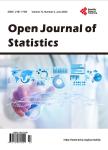Traumatic Brain Injury and Cerebral Vascular Accident: Application of Rasch Analysis to Examine Differences in Disability and Outcome in Post-Hospital Rehabilitation
Traumatic Brain Injury and Cerebral Vascular Accident: Application of Rasch Analysis to Examine Differences in Disability and Outcome in Post-Hospital Rehabilitation作者机构:NeuroRestorative Research Institute Medical College of Georgia Augusta University Augusta USA NeuroRestorative Research Institute College of Medicine Florida State University Orlando USA
出 版 物:《Open Journal of Statistics》 (统计学期刊(英文))
年 卷 期:2018年第8卷第4期
页 面:670-683页
学科分类:1002[医学-临床医学] 100214[医学-肿瘤学] 10[医学]
主 题:Traumatic Brain Injury TBI Cerebrovascular Accident CVA Stroke Outcome Post-Hospital Rehabilitation MPAI-4 Rasch Analysis Functional Assessment
摘 要:The purpose of this study was to demonstrate an application of Rasch analysis to identify differences in disability profiles resulting from traumatic brain injury (TBI) and cerebral vascular accident (CVA) and to examine outcome differences between the two groups following post-hospital residential rehabilitation. Participant data were collected from 32 facilities in 16 states. From 2990 neurologically impaired individuals with consecutive admissions from 2011 through 2017, 874 met inclusion criteria: TBI (n = 687) or CVA (n = 187), 18 years or older, minimum length of stay of one month, and maximum chronicity of 1 year. Participants were evaluated at admission and discharge on the Mayo Portland Adaptability Inventory-Version 4 (MPAI-4). Rasch analysis was performed to establish item reliability, construct validity and item difficulty. A Repeated Measures Multivariate Analysis of Covariance (RM MANCOVA) determined group differences and improvement from admission and discharge. Rasch Analysis demonstrated satisfactory construct validity and internal consistency (Person reliability 0.90, Item reliability 0.98 for admission and discharge MPAI-4s). Both groups showed significant improvement on the MPAI-4 (p 0.0005). The TBI group was more impaired on the adjustment scale at both admission and discharge (p 0.001). Rasch analysis identified two distinct impairment patterns. CVA participants exhibited deficits characteristic of focal impairment while the TBI group presented with deficits reflective of diffuse impairment. Rehabilitation was shown to be beneficial in reducing disability following neurologic injury in both groups. Importantly, Rasch Analysis accurately produced unique disability profiles that differentiated the treatment groups. This unique statistical technique offers a promising prescriptive hierarchical model for guiding neurological rehabilitation treatment.



